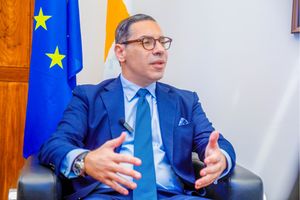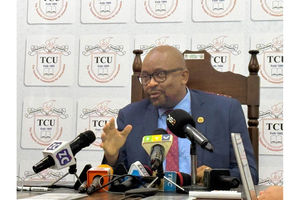Communicating with the hearing-impaired

According to Kassim Kaonekana, this is not like any other form of teaching. It requires dedication and patience. PHOTO I EDWARD QORRO
What you need to know:
Seated on a plastic chair, the man uses his hands and lip-synchs to communicate with a group of people who seem to understand what he is communicating to them. Meet Kassim Kaonekana, a teacher who uses his sign language skills in communicating with the deaf.
One person catches the attention of many activists and guests gathered at the Tanzania Gender Networking Programme offices in Mabibo area.
Seated on a plastic chair, the man uses his hands and lip-synchs to communicate with a group of people who seem to understand what he is communicating to them. Meet Kassim Kaonekana, a teacher who uses his sign language skills in communicating with the deaf.
How did you become a sign language interpreter?
It was at Kisosora Primary School in Tanga back in 1991. I remember the school had a special stream for the hearing impaired students.
They really found it hard catching up with other students because there were very few teachers who knew how to communicate with them. The late Dr Steven Kisanji really inspired me to become one.
Did you go to any college?
Oh yes, in 1994, I went to Tabora Teachers College. It is there where I enrolled in a special programme of communicating with the deaf. I remember it was a one and a half years course.
How unique is the course?
As starters, we learn the basics such as oralism and lip reading. It was a difficult course because some words have similar sounds, and therefore you need to be extra smart to differentiate them while communicating with somebody who is deaf.
When did you eventually become an interpreter?
In November 1995, I came to Dar es Salaam and joined Buguruni Primary School, which is a special school for the deaf where I have been a teacher to-date.
Are there any challenges when speaking with the deaf?
There have been challenges on that, especially for new students who join us but unfortunately lack the basic understanding of the sign language.
It has proven to be a bit difficult understanding them, but as a teacher, my duty is to make people understand and I have always tried to do that.
This is not like any other form of teaching. It requires dedication and patience. If you do not have such traits then you should count yourself in the wrong profession. It is a bit tricky to cope with such students and if you are not careful enough, you could end up giving up.
Unfortunately, those of us who are capable of communicating using the sign language are lowly paid and have not been given any form of motivation.
This has pulled us behind and at times we are forced to multi-task to make ends meet.
Is there anything to smile about since you became a sign language interpreter?
I’m always happy to see students comprehend what I teach them in class even if they cannot hear. Thanks to this profession, I now hold a degree in special education.
When one chooses this profession, their minds should not be focused on money-making but in helping those faced with hearing challenges. I urge other teachers not to shun this profession on financial grounds.



